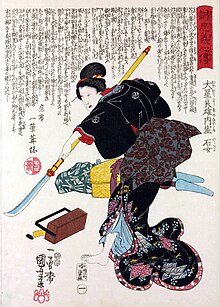Naginatajutsu

|
|
| Focus | Weaponry (Naginata) |
|---|---|
| Hardness | Non-competitive |
| Country of origin |
|
| Creator | Unknown |
| Parenthood | Historical |
| Olympic sport | No |
Naginatajutsu (長刀術 or 薙刀術?) is the Japanese martial art of wielding the naginata (なぎなた?). This is a weapon resembling the medieval European glaive. Most naginatajutsu practiced today is in a modernized form, a gendai budō, in which competitions also are held.
Multiple theories concerning the weapon's exact origins are in debate. It has been suggested that it developed along the same lines as Okinawan kobudō weapons as a modified farming tool. Another theory states that it is the result of the Japanese modifying a Chinese Guan Dao that bears a similar appearance. Others say that a creative samurai in need of a longer weapon attached a sword to a pole.
Perhaps the simplest explanation is the natural development of polearms. Polearms are intended as mass weapons, to be used not just by individual warriors, but by formations of soldiers together on field battles and not for dueling. When fighting in close order, two-handed cut-and-thrust weapons, such as halberds and glaives, are much more efficient than mere spears or swords because of their versatility compared to spears and longer reach compared to swords. Fighting in massed formation does not require similar individual weapon-handling skills as required by a skilled swordsman. Naginata are almost identical in appearance to both the glaive and the guan dao, and it is most likely result of parallel evolution.
In the early history of its use, the naginata was primarily used against cavalry, as its length kept the wielder a safe distance from horses and their riders. During the Tokugawa period (1603–1868), the naginata was transformed into a symbol of status for female samurai, as well as being the primary means for a woman to defend her home while her husband was away at war. This period also saw the propagation of the naginata as a feminine art and the weapon serving as more of a symbol of devotion to a woman's family.
...
Wikipedia
